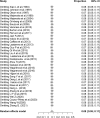Global prevalence and risk factors of Cryptosporidium infection in Equus: A systematic review and meta-analysis
- PMID: 36506009
- PMCID: PMC9732577
- DOI: 10.3389/fcimb.2022.1072385
Global prevalence and risk factors of Cryptosporidium infection in Equus: A systematic review and meta-analysis
Abstract
Intoduction: Cryptosporidiosis is a zoonotic disease caused by Cryptosporidium infection with the main symptom of diarrhea. The present study performed a metaanalysis to determine the global prevalence of Cryptosporidium in Equus animals.
Methods: Data collection was carried out using Chinese National Knowledge Infrastructure (CNKI), VIP Chinese journal database (VIP), WanFang Data, PubMed, and ScienceDirect databases, with 35 articles published before 2021 being included in this systematic analysis. This study analyzed the research data through subgroup analysis and univariate regression analysis to reveal the factors leading to high prevalence. We applied a random effects model (REM) to the metadata.
Results: The total prevalence rate of Cryptosporidium in Equus was estimated to be 7.59% from the selected articles. The prevalence of Cryptosporidium in female Equus was 2.60%. The prevalence of Cryptosporidium in Equus under 1-year-old was 11.06%, which was higher than that of Equus over 1-year-old (2.52%). In the experimental method groups, the positive rate detected by microscopy was the highest (10.52%). The highest Cryptosporidium prevalence was found in scale breeding Equus (7.86%). The horses had the lowest Cryptosporidium prevalence (7.32%) among host groups. C. muris was the most frequently detected genotype in the samples (53.55%). In the groups of geographical factors, the prevalence rate of Cryptosporidium in Equus was higher in regions with low altitude (6.88%), rainy (15.63%), humid (22.69%), and tropical climates (16.46%).
Discussion: The search strategy use of five databases might have caused the omission of some researches. This metaanalysis systematically presented the global prevalence and potential risk factors of Cryptosporidium infection in Equus. The farmers should strengthen the management of young and female Equus animals, improve water filtration systems, reduce stocking densities, and harmless treatment of livestock manure.
Keywords: Cryptosporidium; Equus; meta-analysis; prevalence; zoonotic diseases.
Copyright © 2022 Li, Geng, Wei, Yan, Liu, Wei, Zhang, Wang, Zhang and Liu.
Conflict of interest statement
The authors declare that the research was conducted in the absence of any commercial or financial relationships that could be construed as a potential conflict of interest.
Figures








Similar articles
-
The global prevalence and risk factors of Cryptosporidium infection among cats during 1988-2021: A systematic review and meta-analysis.Microb Pathog. 2021 Sep;158:105096. doi: 10.1016/j.micpath.2021.105096. Epub 2021 Jul 15. Microb Pathog. 2021. PMID: 34273476
-
Prevalence of Cryptosporidium in pigs in China: A systematic review and meta-analysis.Transbound Emerg Dis. 2021 May;68(3):1400-1413. doi: 10.1111/tbed.13806. Epub 2020 Sep 8. Transbound Emerg Dis. 2021. PMID: 32815651
-
Prevalence of Cryptosporidium spp. in Yaks (Bos grunniens) in China: A Systematic Review and Meta-Analysis.Front Cell Infect Microbiol. 2021 Oct 18;11:770612. doi: 10.3389/fcimb.2021.770612. eCollection 2021. Front Cell Infect Microbiol. 2021. PMID: 34733797 Free PMC article.
-
Prevalence of Cryptosporidium in dairy cattle in China during 2008-2018: A systematic review and meta-analysis.Microb Pathog. 2019 Jul;132:193-200. doi: 10.1016/j.micpath.2019.05.006. Epub 2019 May 7. Microb Pathog. 2019. PMID: 31075427
-
Prevalence of Cryptosporidium infection in children from China: a systematic review and meta-analysis.Acta Trop. 2023 Aug;244:106958. doi: 10.1016/j.actatropica.2023.106958. Epub 2023 May 29. Acta Trop. 2023. PMID: 37257675
Cited by
-
Epidemiology of Cryptosporidium Infection in Romania: A Review.Microorganisms. 2023 Jul 12;11(7):1793. doi: 10.3390/microorganisms11071793. Microorganisms. 2023. PMID: 37512965 Free PMC article. Review.
-
Global epidemiology and species/genotype distribution of Cryptosporidium in camels: A systematic review and meta-analysis.Food Waterborne Parasitol. 2024 Jul 11;36:e00235. doi: 10.1016/j.fawpar.2024.e00235. eCollection 2024 Sep. Food Waterborne Parasitol. 2024. PMID: 39109171 Free PMC article. Review.
-
Prevalence of Cryptosporidium spp. infection in rodents and chickens in Franceville, Gabon.Vet World. 2024 Jul;17(7):1523-1529. doi: 10.14202/vetworld.2024.1523-1529. Epub 2024 Jul 13. Vet World. 2024. PMID: 39185057 Free PMC article.
-
Anti-Cryptosporidium oocysts polyclonal antibodies for cryptosporidiosis diagnosis and protection.AMB Express. 2023 Nov 9;13(1):125. doi: 10.1186/s13568-023-01632-w. AMB Express. 2023. PMID: 37943403 Free PMC article.
-
Investigation of Cryptosporidium spp. and Enterocytozoon bieneusi in free-ranged livestock on the southeastern Qinghai-Xizang Plateau, China.BMC Infect Dis. 2025 Mar 13;25(1):356. doi: 10.1186/s12879-025-10737-5. BMC Infect Dis. 2025. PMID: 40082808 Free PMC article.

